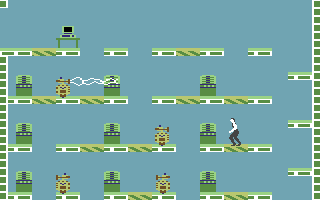An entry in the webxr category of the 2020 js13kgames competition
Play it here: https://js13kgames.com/entries/exit
Below is the post-mortem. For other entry post-mortems, see https://js13kgames.github.io/resources/
The idea for the game was to be a stealth/puzzle type game where the player had to guide creatures to an exit without them being found by robots. The creatures wouldn't be controlled directly, but influenced by placing items on the play area. The play area of the game would be presented as a table top game in front of the player. Influences for this were Lemmings, Chu Chu Rocket, Hitman Go.
The robots would have predictable behaviours which would allow the player to plan on how to avoid them.
Impossible Mission on Commodore 64:

The intention was for the game to be playable on desktop, mobile and both 3 Degrees of Freedom and 6 Degrees of Freedom VR headsets.
At the time of developing the project there seemed to be a range of different controllers that were used for VR. In order to be usable on most VR devices as well as mobile and desktop, the controls were limited to a pointer device with one button. If the player owned two VR controllers, it would allow them to use both.
Compatibility with 3 DoF VR devices and Desktop/Mobile with only a pointer meant the game couldn't rely on the user being able to walk around the play area. Teleportation is a solution to this, but I thought for a simple game, adding teleportation controls might complicate it. Another solution would have been to allow the player to rotate the play area.
Motion sickness can be a problem for VR games. Having the gameplay area appear as like a table in front of the player was an idea of how to get around this. Motion in the game was limited to just the creatures and the robots.
Another aim was to not have the jarring effect in VR of a sharp switch between levels, but also keep with the idea of limiting object movement. The idea to solve this was for each of the grid cubes which make up the current level to shrink to nothing and then the grid cells for the next level to expand to take their place.
The aim for the design of the puzzles was to start easy, then increase the difficulty, but also add in levels which were 'easy but rewarding'. There would be some levels which introduce a new concept and then later levels test the use of that concept, or the combination of concepts. However, the game can't take too long in introducing the concepts, as players can get bored/frustrated if it is taking too long to get to the main game. Also, designing and testing puzzles can be difficult, as once you know the solution to the puzzle, you can lose track of how difficult/easy it is, so playtesting with other people would be important. Some puzzles were to be timing based, but not have to rely too much on player reflexes.
The puzzles would be playable on desktop computer, but 3d awareness in vr would give an advantage. The limitation of being playable on desktop and 3 DOF VR headsets did limit the layout for levels from what i was initially imagining. In hindsight, maybe the table should have been able to be rotated by the player. Testing would have to had been done to see if this would cause motion sickness.
I wanted it to be visible to the player how many levels there are, and their progression, as seeing progression and having a goal can provide incentive to keep playing.
This was my first project in A-Frame, so wasn't always sure if I was doing things the correct way. The HTML document defined the position of the main elements and then the dynamic elements were created with document.createElement().
All game objects are composed of simple shapes and are placed within a 3d grid.
The aim was to keep the sound simple to match the simple nature of the graphics. Each action/event in the game would have a corresponding sound.
I had access to a Daydream headset/controller (now discontinued) with a Pixel phone for testing. This is a 3 DOF device.
I also had access to a Vive headset. This is the main device I used testing. The set up for the Vive headset wasn't great (the base stations sat on top of piles of books) and which direction was 'forward' seemed to change each time I started the game.
I left testing in VR until too late in the project. I didn't have a proper VR setup, so for most of the timeframe of development I was developing and testing on a desktop computer. When I eventually came to testing in VR I found a few problems, such as you'd have to hold the controller at an uncomfortable angle to reach certain squares on the board, or in 3 DOF headsets it might be very difficult or impossible to see some squares because of obstacles blocking them. As I'd left VR testing so late, I had to rush to redesign levels to suit the VR.
I ran out of time on the project and while rushing to finish forgot some of the items on my to do list, for example the characters were meant to be placeholders until I came up with something better, there were elements of polish I wanted to add but never got to.
Even though they weren't intended to be final, I think the design of the creatures and robots look ok. I think it was a good decision to aim for a game that was also playable on mobile and desktop.

